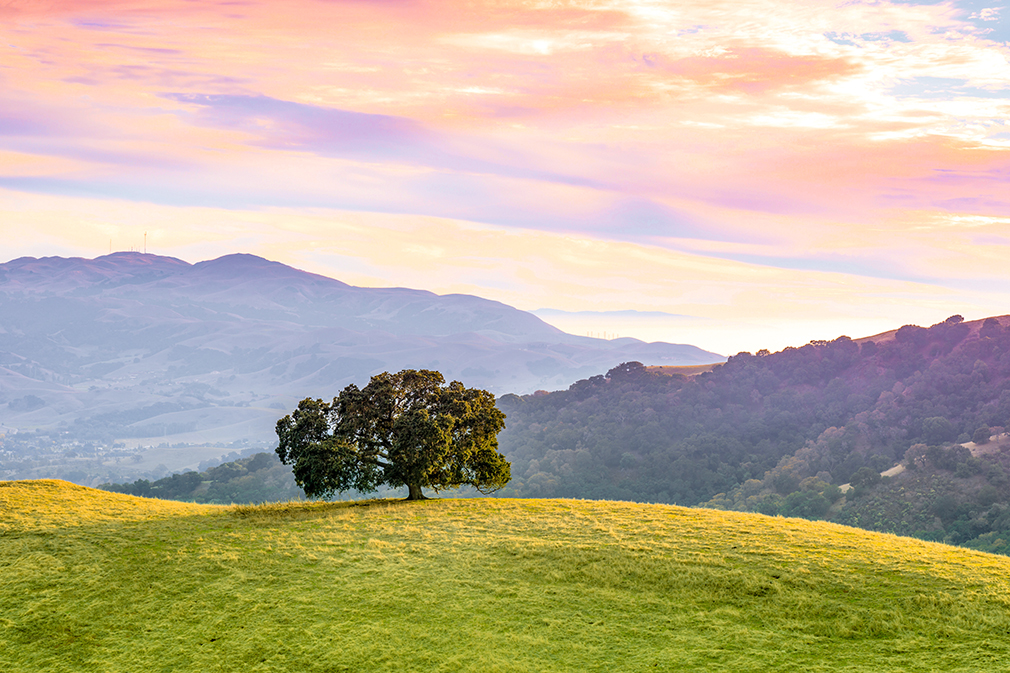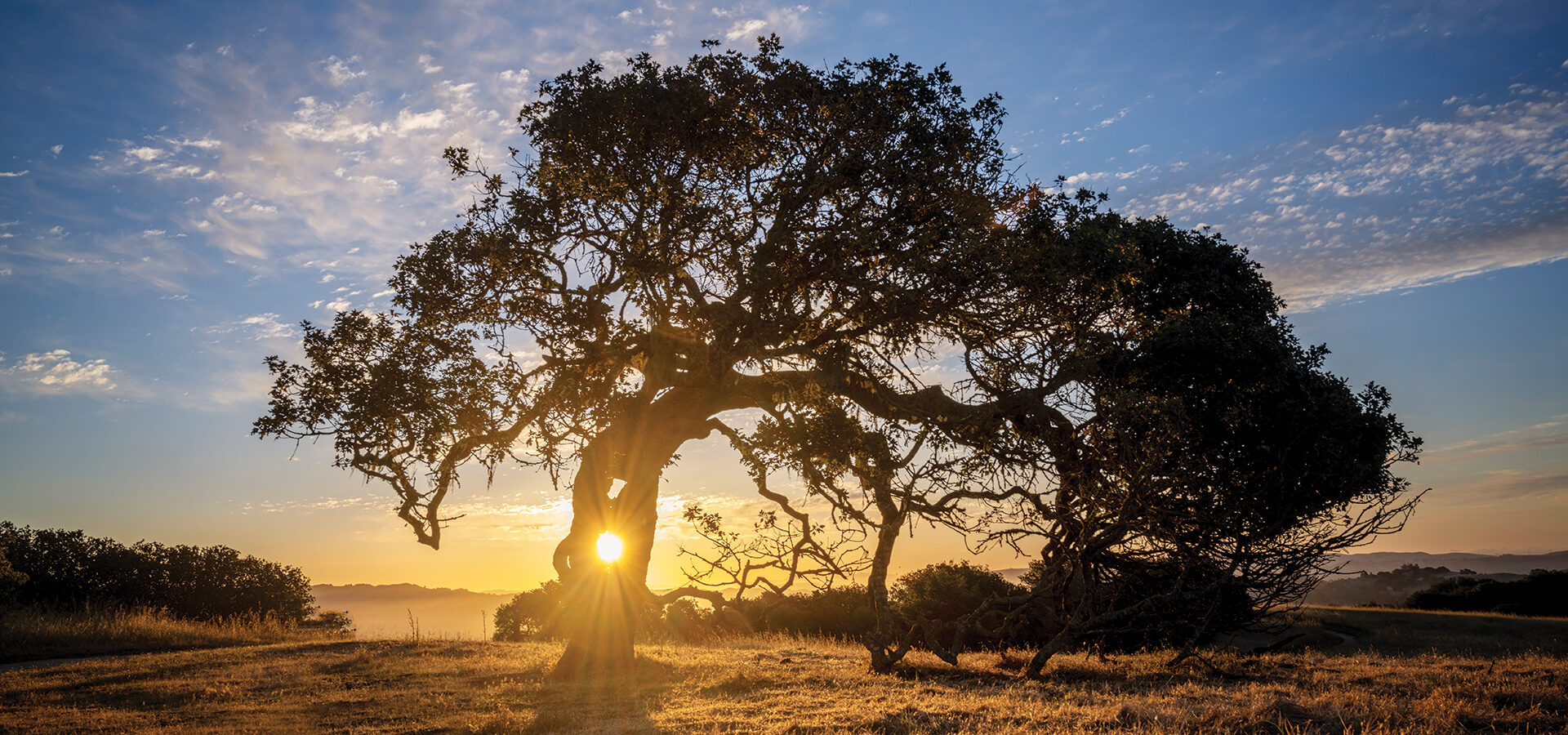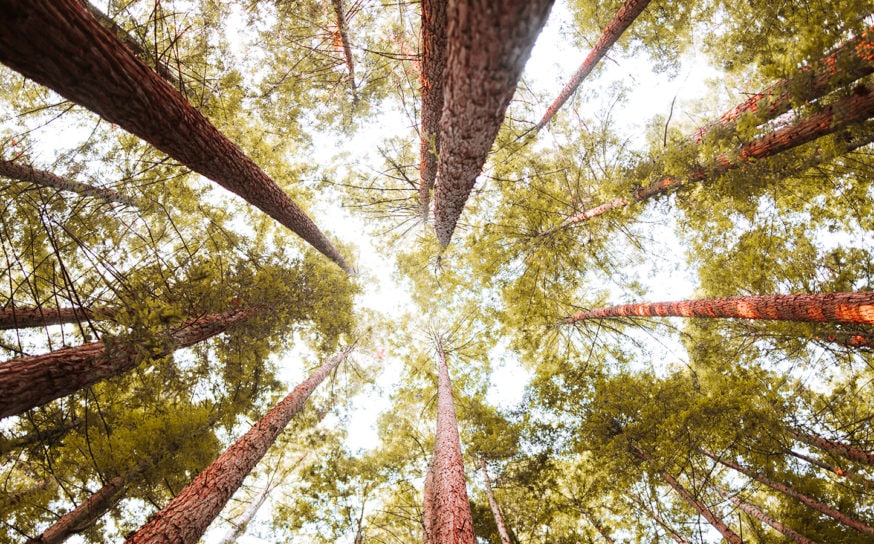This Earth Day We Honor the Majestic Legacy of the California Oak
Plus, tips on care.
-
CategoryLife Outside, Outdoor Adventure, Road Trips
-
Written byRobert Earle Howells
California oak trees live in my heart and soul. I miss them when I travel, and they signify “home” when I return. They dazzle me, enchant me, and make me think I’m a photographer, because simply aiming a camera in their general direction yields a masterpiece every time. (Which is why my phone is full of “oak porn.”) How often do I stop the car to admire a magnificent oak tree? More than my wife cares to count.
Happily, opportunities to pull over and go gaga over an oak tree are ubiquitous all up and down the hills and valleys of California west of the Sierra. Every other street or development carries some version of “oak” in its name. Heck, the very word “Encino” is Spanish for oak. “Thousand Oaks” is English for “probably more like a million oaks.” Oak trees line our streets, cluster along our hiking trails, shade our parks—and they are so beautiful.
But it’s more than beauty and ubiquity that endears me to California oaks. There’s a lot going on with these majestic specimens. What exactly? I decided to seek out some fellow oak zealots to learn more and to help me articulate our mutual obsession.
The Arborist
Alison Lancaster is a consulting arborist whose right forearm is tattooed with oak leaves and a cluster of acorns. She’s also the resident oak expert at Theodore Payne Foundation, the native-plant mecca in Sun Valley, where she conducts tree walks and Ask An Arborist sessions.
“They symbolize resilience, adaptability, perseverance—qualities I want to cultivate in myself,” says Alison. The world has 500 species of oaks, she points out, but only our SoCal versions are adapted to the rigors of a Mediterranean climate. A beast that spreads its gnarled branches to form a 100-foot canopy manages to thrive despite our long periods of drought.
Of the five species native to the LA basin, two are predominant in the Valley and surrounding hills: coast live oak and valley oak. They’re fairly easy to distinguish: Valley oaks are deciduous; coast live oaks are evergreen. Fun fact: “Roble,” (as in Paso Robles), is another Spanish word for oak, and refers to the valley oak; encinos are coast live oaks.
“Both species are very well suited to our terrible soil,” Alison says. “They’ll practically grow out of solid granite.” Meaning you don’t need a green thumb or a magic touch to grow one.
Like all of my fellow zealots, Alison extols the value of habitat. “I think of them as community centers for wildlife. For birds you might not even expect, like hummingbirds and birds of prey. Insects and microbial life. Critters living in the leaf litter. Habitat may be the biggest benefit they provide.”
Mr. Ranger
As a restoration ecologist, Joey Algiers is devoted to preserving and restoring oaks and their habitat in the Santa Monica Mountains National Recreation Area. He has a personal affinity for oaks (“my favorite tree”), and also a deep concern. “We lost over 10,000 coast live oak trees in the drought years (2012–18) before the Woolsey Fire,” says Joey, “so you can imagine how stressed the trees were after the fire. We lost thousands more.” (The park service has since planted more than 7,000 new oaks.) He also cites the arrival of tree-boring insects and the growing intensity of fires—both related to climate change—as major threats. “Oak trees are fire-resilient,” he says. “They do a good job of bouncing back and even trapping embers. But if you subject them too often to fire, they will suffer, especially with droughts becoming more extreme and common.”
The ranger easily switches from concern to admiration. “They’re beautiful and crazy trees. The Santa Monicas are predominantly a shrub landscape, so these majestic trees really stand out.” And, of course, provide fecund habitat. “They have this incredible rich canopy and amazing root structures so deep they find groundwater. So they make incredible habitat. Acorn woodpeckers love them; you’ll see their granaries that look like they’ve been sprayed with machine gun fire. Those are acorn stashes.”
Humans benefit too. “The first thing is shade, so important for human communities. Plus they provide clean air, absorb carbon, and whether we realize it or not, they do something for us on a therapeutic level.”

TreePerson
Few people have personally planted more oak trees than Andy Lipkis, founder of TreePeople, the Coldwater Canyon-based nonprofit that has for 50 years spearheaded community efforts to plant and care for trees.
“They are stunning,” says the veteran activist and ecologist. “They are also the model of what we need to biomimic. For example, I’ve recently put in a 1,000-gallon cistern at my home. It and oak trees go hand in hand, because a large oak can hold 120,000 gallons of water in its root system after a storm.”
That large tree’s root zone is reaching well beyond its canopy diameter, and is all the while dropping leaves—“making mulch and making mulch and making mulch. It’s creating 5 to 6 feet of soil—extraordinary habitat for creatures from microscopic animals to squirrels and snakes.”
That soil also cleans contaminants as water flows through it. “That oak tree is a wastewater treatment plant. It’s a sponge and it’s a tank. It’s a flood-control system. And it provides cooling, air-conditioning, and air filtration.”
Oak trees are theoretically protected in LA County, which prohibits removing or damaging them without a permit. But the ordinance is difficult to enforce, and tree-deaf folks seem to find ways around it.
When that happens, we lose the services it provides. “Whoever is removing that tree is not replacing those systems,” Lipkis contends. “That’s not in the calculation. I see the tree as living infrastructure that is critical for life. You have to replace it with bureaucracy, with a flood-control system, a water-supply system, fire suppression, pollution control. We believe in technology, but not in ourselves and our nature. That leaves us more and more vulnerable. This is why TreePeople is one word. When we separate trees from people, we get in trouble.”
My conversations with fellow tree people were focused on the present day, but I’m well aware of how our native predecessors valued oaks. In particular, they relied on the food value of acorns, which they ground into a mush to bake bread. But Andy Lipkis told me about another native practice: that Native Americans when sick would simply sit and lean against a tree. That strikes me as a wonderful practice, whether I’m ill or healthy. Oak trees have so much life, energy, presence, inherent wisdom. I plan to sit under them as often as I can.
WHERE THE TREES ARE
LOCAL PLACES WHERE YOU CAN ENJOY BEAUTIFUL OAK TREES
Orcutt Ranch Horticultural Center. Several gigantic oaks in this West Hill enclave, including one estimated to be 700 years old.
Topanga State Park. All around the headquarters at Trippet Ranch and on virtually every hiking trail.
Malibu Creek State Park. Many are silhouetted against dramatic mountain backdrops. Amazing density in the Tapia Park Day Use Area just south of the main park entrance.
Santa Monica Mountains National Recreation Area. You don’t have to venture far to see stellar oaks in Cheeseboro Canyon or Paramount Ranch.
East Valley Parks. Franklin Canyon, Fryman Canyon, and Coldwater Canyon (home of TreePeople) Parks all have beautiful oaks.
CARE AND FEEDING
TIPS FROM OUR EXPERTS
Planting. A small plant, e.g., 5 gallons, will have fewer root issues from having been in a container. Dig your hole twice the size of the plant, and then pack it tight. Don’t add amendment. Give it 2 to 5 gallons of water, slowly, then water biweekly for the next year.
Watering. Oaks are drought-tolerant, so mature trees don’t need much water. Never allow sprinklers to spray the trunk. Don’t place drip tubing within 10 feet of a mature tree trunk. Don’t change your watering regimen without consulting an arborist. For example, if you’re removing a lawn, don’t just stop watering the tree.
Pruning. “Oak trees don’t need to be pruned for their own sake,” says Alison Lancaster. If possible, just don’t prune. Also, sprouts and shoots coming off branches and trunks are beneficial. Leave them alone. If there’s a safety issue or you suspect a branch is diseased, contact a consulting arborist. “We’ll give you an independent recommendation,” says Alison. “Then a pruning company can do the work.”
Understanding California Redwoods’ Genetic Code May Be the Key to Their Survival
Ninety-five percent of California’s old growth trees have already been wiped out.
LA-Based Brother Duo Cones Debut Full-Length Album
“Moonstone” is the latest gem off the forthcoming Pictures of Pictures.
Volunteers Use the Ocean to Deliver Supplies to Those Affected by the Woolsey Fire
Communities come together for a bit of good news and good will.
Get the Latest Stories







